UTS Taxation Law 77938: Analyzing Kate's Income and Deductions
VerifiedAdded on 2023/06/11
|9
|1977
|303
Case Study
AI Summary
This case study analyzes Kate's income as an accountant and athlete for the 2017-18 tax year, determining assessable income under Section 6-5 of the ITAA 1997 and allowable deductions under Section 8-1. The analysis covers salary, awards, sporting income, capital gains from collectibles, rental income, and payments for media appearances. It applies relevant case law, including Scott v Commissioner of Taxation and FCT v Stone, to determine taxability. Expenses related to seeking new employment are deemed non-deductible. The study concludes that Kate's taxable income is $90,000, with a basic tax liability of $20,932, and rental property expenses are allowable deductions. Desklib provides this solution and other study resources for students.
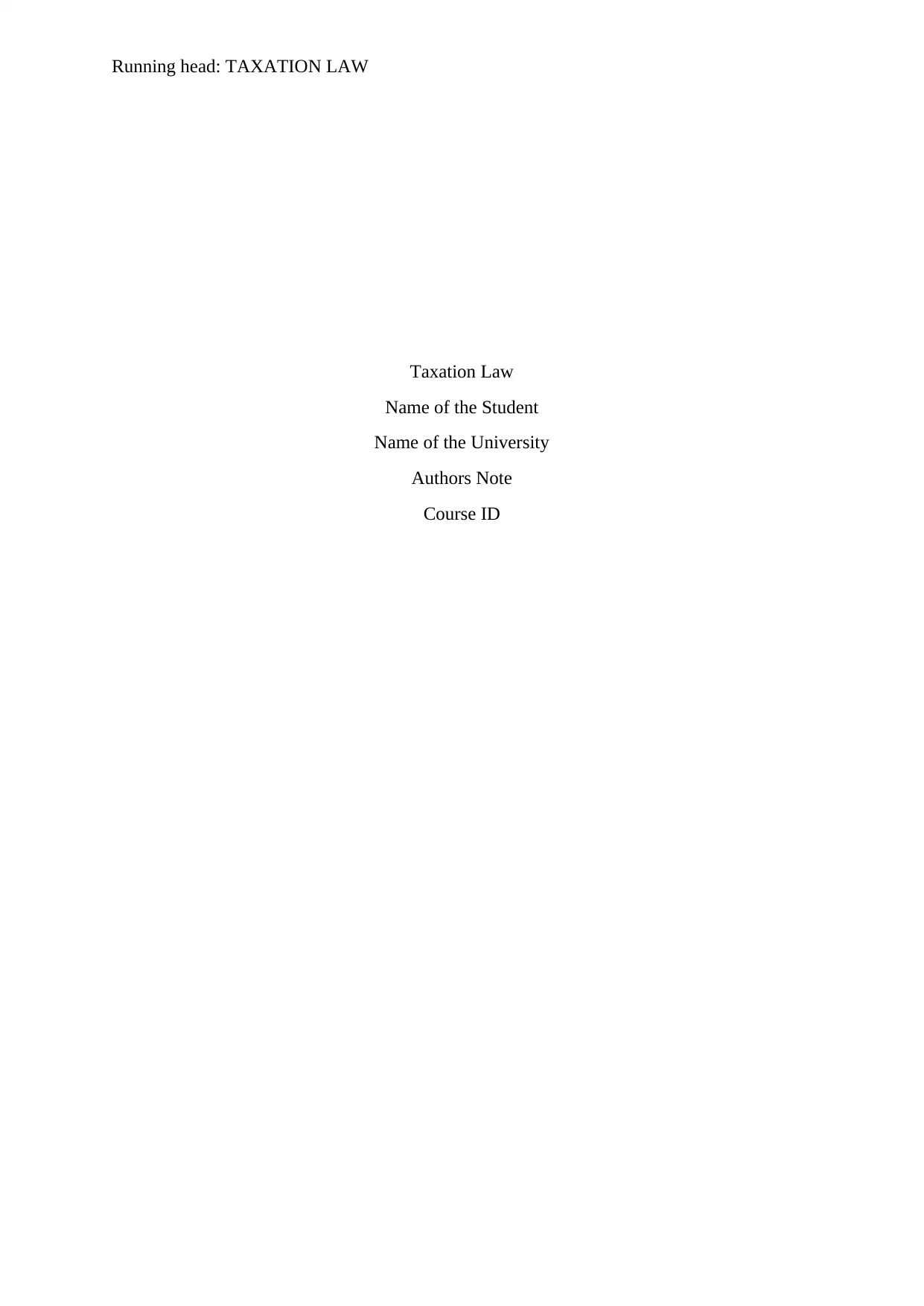
Running head: TAXATION LAW
Taxation Law
Name of the Student
Name of the University
Authors Note
Course ID
Taxation Law
Name of the Student
Name of the University
Authors Note
Course ID
Paraphrase This Document
Need a fresh take? Get an instant paraphrase of this document with our AI Paraphraser
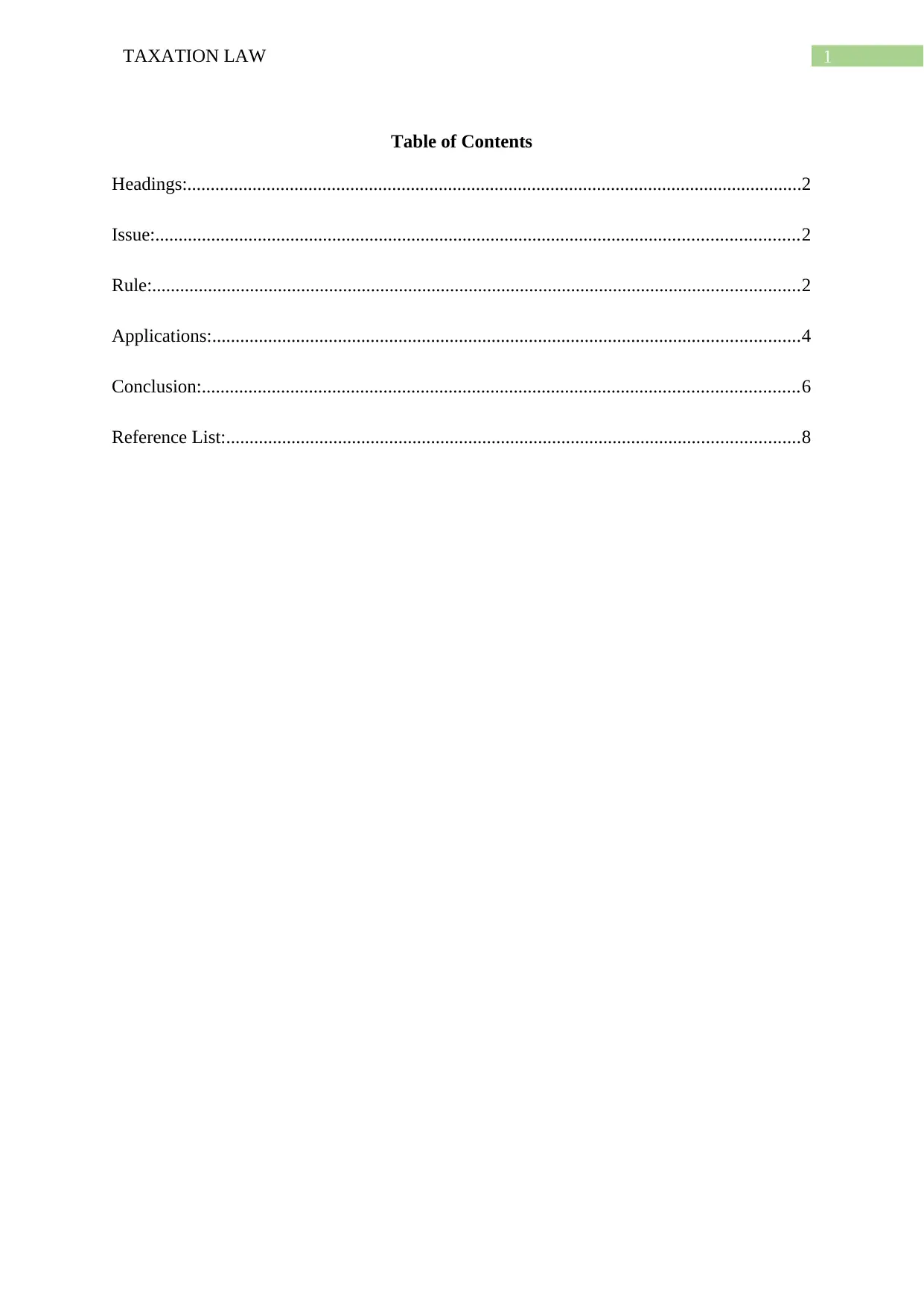
1TAXATION LAW
Table of Contents
Headings:....................................................................................................................................2
Issue:..........................................................................................................................................2
Rule:...........................................................................................................................................2
Applications:..............................................................................................................................4
Conclusion:................................................................................................................................6
Reference List:...........................................................................................................................8
Table of Contents
Headings:....................................................................................................................................2
Issue:..........................................................................................................................................2
Rule:...........................................................................................................................................2
Applications:..............................................................................................................................4
Conclusion:................................................................................................................................6
Reference List:...........................................................................................................................8
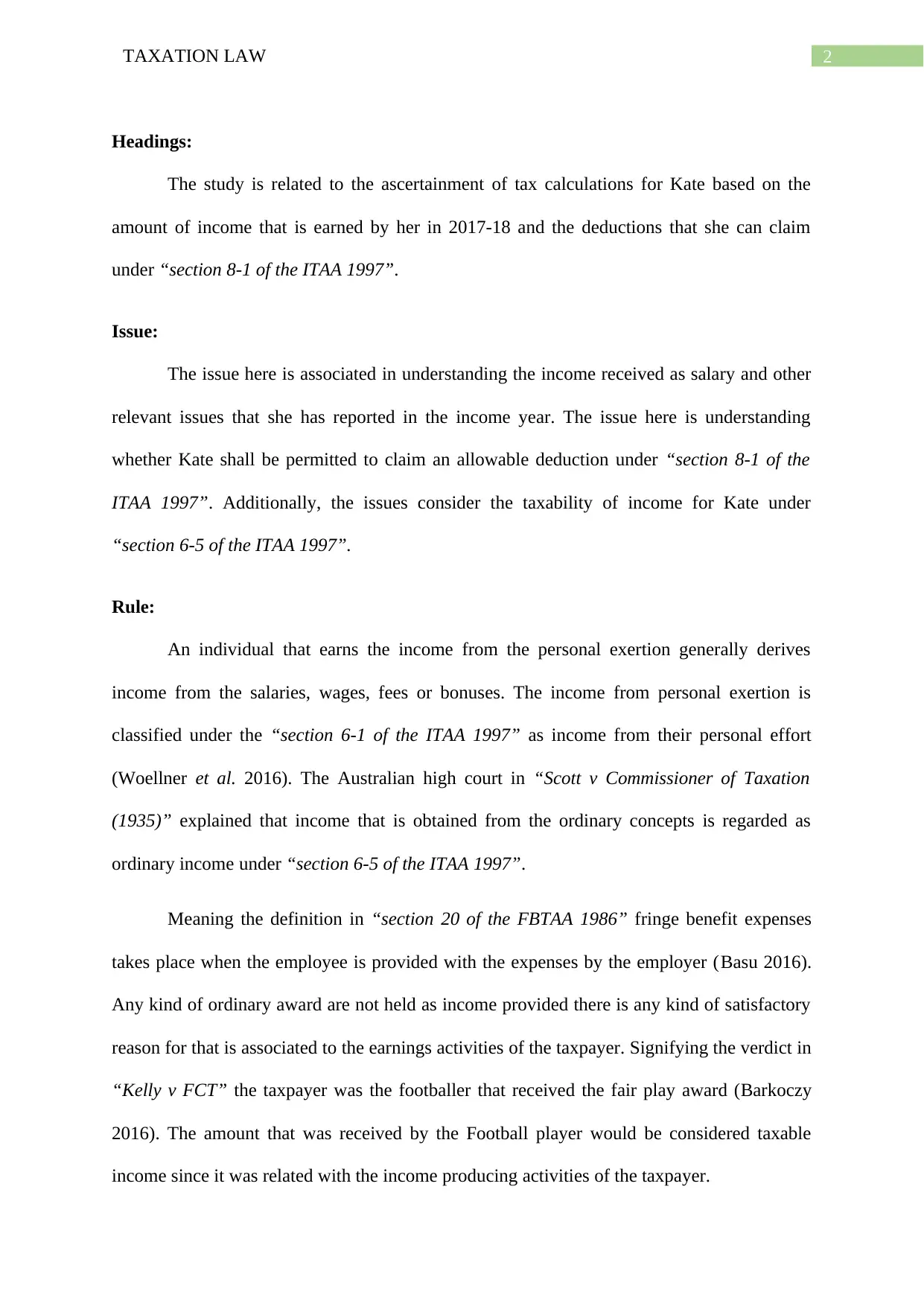
2TAXATION LAW
Headings:
The study is related to the ascertainment of tax calculations for Kate based on the
amount of income that is earned by her in 2017-18 and the deductions that she can claim
under “section 8-1 of the ITAA 1997”.
Issue:
The issue here is associated in understanding the income received as salary and other
relevant issues that she has reported in the income year. The issue here is understanding
whether Kate shall be permitted to claim an allowable deduction under “section 8-1 of the
ITAA 1997”. Additionally, the issues consider the taxability of income for Kate under
“section 6-5 of the ITAA 1997”.
Rule:
An individual that earns the income from the personal exertion generally derives
income from the salaries, wages, fees or bonuses. The income from personal exertion is
classified under the “section 6-1 of the ITAA 1997” as income from their personal effort
(Woellner et al. 2016). The Australian high court in “Scott v Commissioner of Taxation
(1935)” explained that income that is obtained from the ordinary concepts is regarded as
ordinary income under “section 6-5 of the ITAA 1997”.
Meaning the definition in “section 20 of the FBTAA 1986” fringe benefit expenses
takes place when the employee is provided with the expenses by the employer (Basu 2016).
Any kind of ordinary award are not held as income provided there is any kind of satisfactory
reason for that is associated to the earnings activities of the taxpayer. Signifying the verdict in
“Kelly v FCT” the taxpayer was the footballer that received the fair play award (Barkoczy
2016). The amount that was received by the Football player would be considered taxable
income since it was related with the income producing activities of the taxpayer.
Headings:
The study is related to the ascertainment of tax calculations for Kate based on the
amount of income that is earned by her in 2017-18 and the deductions that she can claim
under “section 8-1 of the ITAA 1997”.
Issue:
The issue here is associated in understanding the income received as salary and other
relevant issues that she has reported in the income year. The issue here is understanding
whether Kate shall be permitted to claim an allowable deduction under “section 8-1 of the
ITAA 1997”. Additionally, the issues consider the taxability of income for Kate under
“section 6-5 of the ITAA 1997”.
Rule:
An individual that earns the income from the personal exertion generally derives
income from the salaries, wages, fees or bonuses. The income from personal exertion is
classified under the “section 6-1 of the ITAA 1997” as income from their personal effort
(Woellner et al. 2016). The Australian high court in “Scott v Commissioner of Taxation
(1935)” explained that income that is obtained from the ordinary concepts is regarded as
ordinary income under “section 6-5 of the ITAA 1997”.
Meaning the definition in “section 20 of the FBTAA 1986” fringe benefit expenses
takes place when the employee is provided with the expenses by the employer (Basu 2016).
Any kind of ordinary award are not held as income provided there is any kind of satisfactory
reason for that is associated to the earnings activities of the taxpayer. Signifying the verdict in
“Kelly v FCT” the taxpayer was the footballer that received the fair play award (Barkoczy
2016). The amount that was received by the Football player would be considered taxable
income since it was related with the income producing activities of the taxpayer.
⊘ This is a preview!⊘
Do you want full access?
Subscribe today to unlock all pages.

Trusted by 1+ million students worldwide
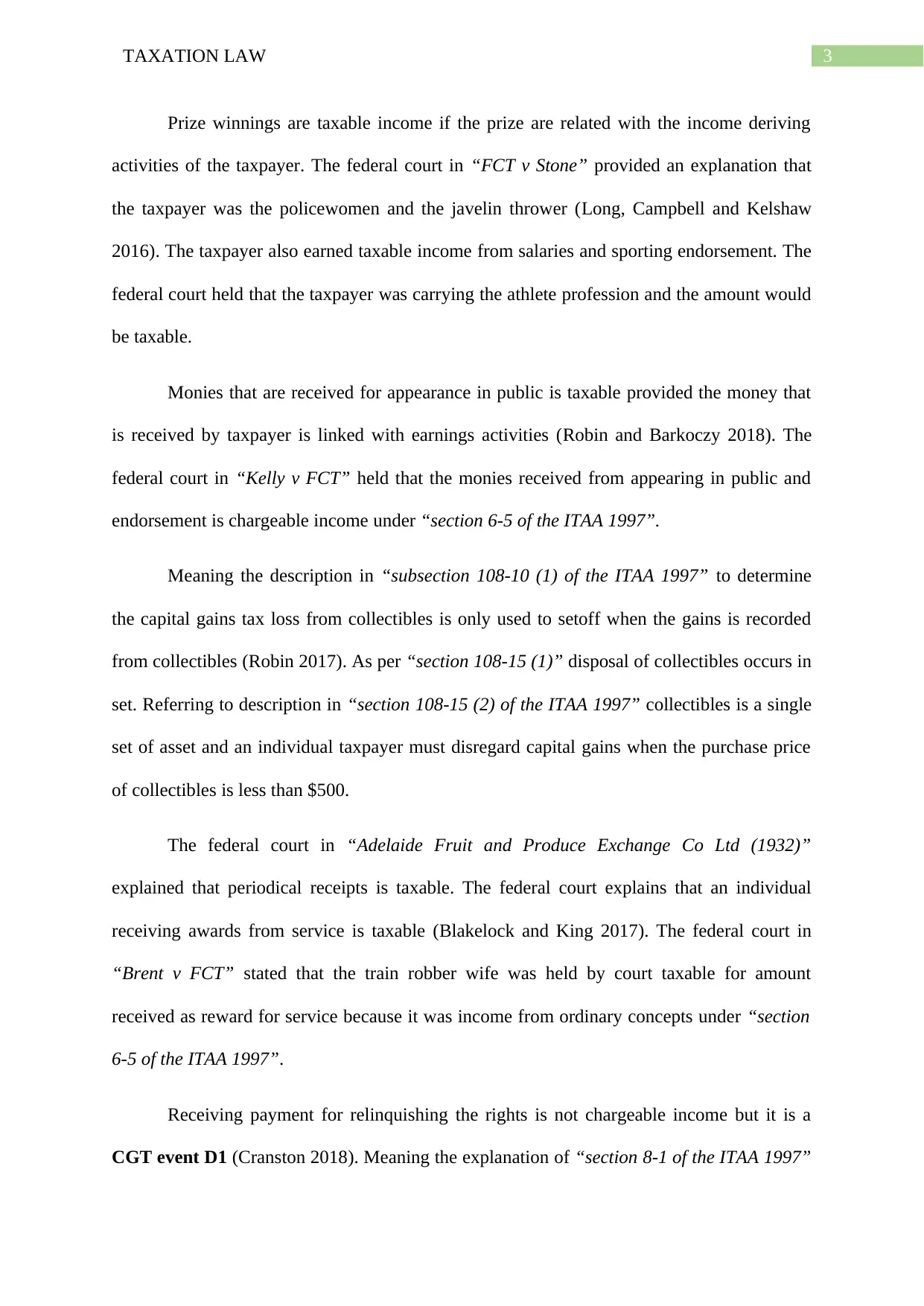
3TAXATION LAW
Prize winnings are taxable income if the prize are related with the income deriving
activities of the taxpayer. The federal court in “FCT v Stone” provided an explanation that
the taxpayer was the policewomen and the javelin thrower (Long, Campbell and Kelshaw
2016). The taxpayer also earned taxable income from salaries and sporting endorsement. The
federal court held that the taxpayer was carrying the athlete profession and the amount would
be taxable.
Monies that are received for appearance in public is taxable provided the money that
is received by taxpayer is linked with earnings activities (Robin and Barkoczy 2018). The
federal court in “Kelly v FCT” held that the monies received from appearing in public and
endorsement is chargeable income under “section 6-5 of the ITAA 1997”.
Meaning the description in “subsection 108-10 (1) of the ITAA 1997” to determine
the capital gains tax loss from collectibles is only used to setoff when the gains is recorded
from collectibles (Robin 2017). As per “section 108-15 (1)” disposal of collectibles occurs in
set. Referring to description in “section 108-15 (2) of the ITAA 1997” collectibles is a single
set of asset and an individual taxpayer must disregard capital gains when the purchase price
of collectibles is less than $500.
The federal court in “Adelaide Fruit and Produce Exchange Co Ltd (1932)”
explained that periodical receipts is taxable. The federal court explains that an individual
receiving awards from service is taxable (Blakelock and King 2017). The federal court in
“Brent v FCT” stated that the train robber wife was held by court taxable for amount
received as reward for service because it was income from ordinary concepts under “section
6-5 of the ITAA 1997”.
Receiving payment for relinquishing the rights is not chargeable income but it is a
CGT event D1 (Cranston 2018). Meaning the explanation of “section 8-1 of the ITAA 1997”
Prize winnings are taxable income if the prize are related with the income deriving
activities of the taxpayer. The federal court in “FCT v Stone” provided an explanation that
the taxpayer was the policewomen and the javelin thrower (Long, Campbell and Kelshaw
2016). The taxpayer also earned taxable income from salaries and sporting endorsement. The
federal court held that the taxpayer was carrying the athlete profession and the amount would
be taxable.
Monies that are received for appearance in public is taxable provided the money that
is received by taxpayer is linked with earnings activities (Robin and Barkoczy 2018). The
federal court in “Kelly v FCT” held that the monies received from appearing in public and
endorsement is chargeable income under “section 6-5 of the ITAA 1997”.
Meaning the description in “subsection 108-10 (1) of the ITAA 1997” to determine
the capital gains tax loss from collectibles is only used to setoff when the gains is recorded
from collectibles (Robin 2017). As per “section 108-15 (1)” disposal of collectibles occurs in
set. Referring to description in “section 108-15 (2) of the ITAA 1997” collectibles is a single
set of asset and an individual taxpayer must disregard capital gains when the purchase price
of collectibles is less than $500.
The federal court in “Adelaide Fruit and Produce Exchange Co Ltd (1932)”
explained that periodical receipts is taxable. The federal court explains that an individual
receiving awards from service is taxable (Blakelock and King 2017). The federal court in
“Brent v FCT” stated that the train robber wife was held by court taxable for amount
received as reward for service because it was income from ordinary concepts under “section
6-5 of the ITAA 1997”.
Receiving payment for relinquishing the rights is not chargeable income but it is a
CGT event D1 (Cranston 2018). Meaning the explanation of “section 8-1 of the ITAA 1997”
Paraphrase This Document
Need a fresh take? Get an instant paraphrase of this document with our AI Paraphraser
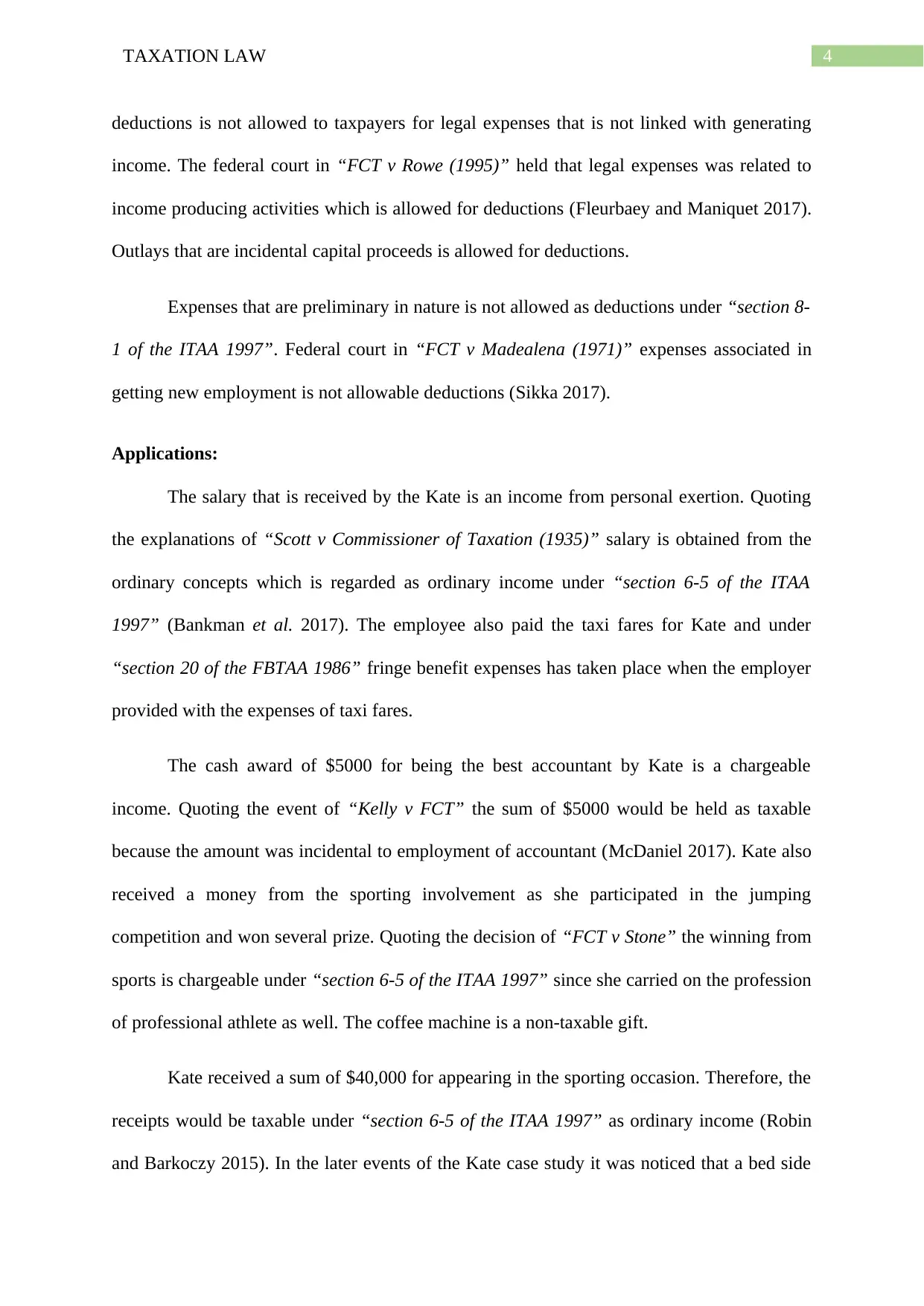
4TAXATION LAW
deductions is not allowed to taxpayers for legal expenses that is not linked with generating
income. The federal court in “FCT v Rowe (1995)” held that legal expenses was related to
income producing activities which is allowed for deductions (Fleurbaey and Maniquet 2017).
Outlays that are incidental capital proceeds is allowed for deductions.
Expenses that are preliminary in nature is not allowed as deductions under “section 8-
1 of the ITAA 1997”. Federal court in “FCT v Madealena (1971)” expenses associated in
getting new employment is not allowable deductions (Sikka 2017).
Applications:
The salary that is received by the Kate is an income from personal exertion. Quoting
the explanations of “Scott v Commissioner of Taxation (1935)” salary is obtained from the
ordinary concepts which is regarded as ordinary income under “section 6-5 of the ITAA
1997” (Bankman et al. 2017). The employee also paid the taxi fares for Kate and under
“section 20 of the FBTAA 1986” fringe benefit expenses has taken place when the employer
provided with the expenses of taxi fares.
The cash award of $5000 for being the best accountant by Kate is a chargeable
income. Quoting the event of “Kelly v FCT” the sum of $5000 would be held as taxable
because the amount was incidental to employment of accountant (McDaniel 2017). Kate also
received a money from the sporting involvement as she participated in the jumping
competition and won several prize. Quoting the decision of “FCT v Stone” the winning from
sports is chargeable under “section 6-5 of the ITAA 1997” since she carried on the profession
of professional athlete as well. The coffee machine is a non-taxable gift.
Kate received a sum of $40,000 for appearing in the sporting occasion. Therefore, the
receipts would be taxable under “section 6-5 of the ITAA 1997” as ordinary income (Robin
and Barkoczy 2015). In the later events of the Kate case study it was noticed that a bed side
deductions is not allowed to taxpayers for legal expenses that is not linked with generating
income. The federal court in “FCT v Rowe (1995)” held that legal expenses was related to
income producing activities which is allowed for deductions (Fleurbaey and Maniquet 2017).
Outlays that are incidental capital proceeds is allowed for deductions.
Expenses that are preliminary in nature is not allowed as deductions under “section 8-
1 of the ITAA 1997”. Federal court in “FCT v Madealena (1971)” expenses associated in
getting new employment is not allowable deductions (Sikka 2017).
Applications:
The salary that is received by the Kate is an income from personal exertion. Quoting
the explanations of “Scott v Commissioner of Taxation (1935)” salary is obtained from the
ordinary concepts which is regarded as ordinary income under “section 6-5 of the ITAA
1997” (Bankman et al. 2017). The employee also paid the taxi fares for Kate and under
“section 20 of the FBTAA 1986” fringe benefit expenses has taken place when the employer
provided with the expenses of taxi fares.
The cash award of $5000 for being the best accountant by Kate is a chargeable
income. Quoting the event of “Kelly v FCT” the sum of $5000 would be held as taxable
because the amount was incidental to employment of accountant (McDaniel 2017). Kate also
received a money from the sporting involvement as she participated in the jumping
competition and won several prize. Quoting the decision of “FCT v Stone” the winning from
sports is chargeable under “section 6-5 of the ITAA 1997” since she carried on the profession
of professional athlete as well. The coffee machine is a non-taxable gift.
Kate received a sum of $40,000 for appearing in the sporting occasion. Therefore, the
receipts would be taxable under “section 6-5 of the ITAA 1997” as ordinary income (Robin
and Barkoczy 2015). In the later events of the Kate case study it was noticed that a bed side
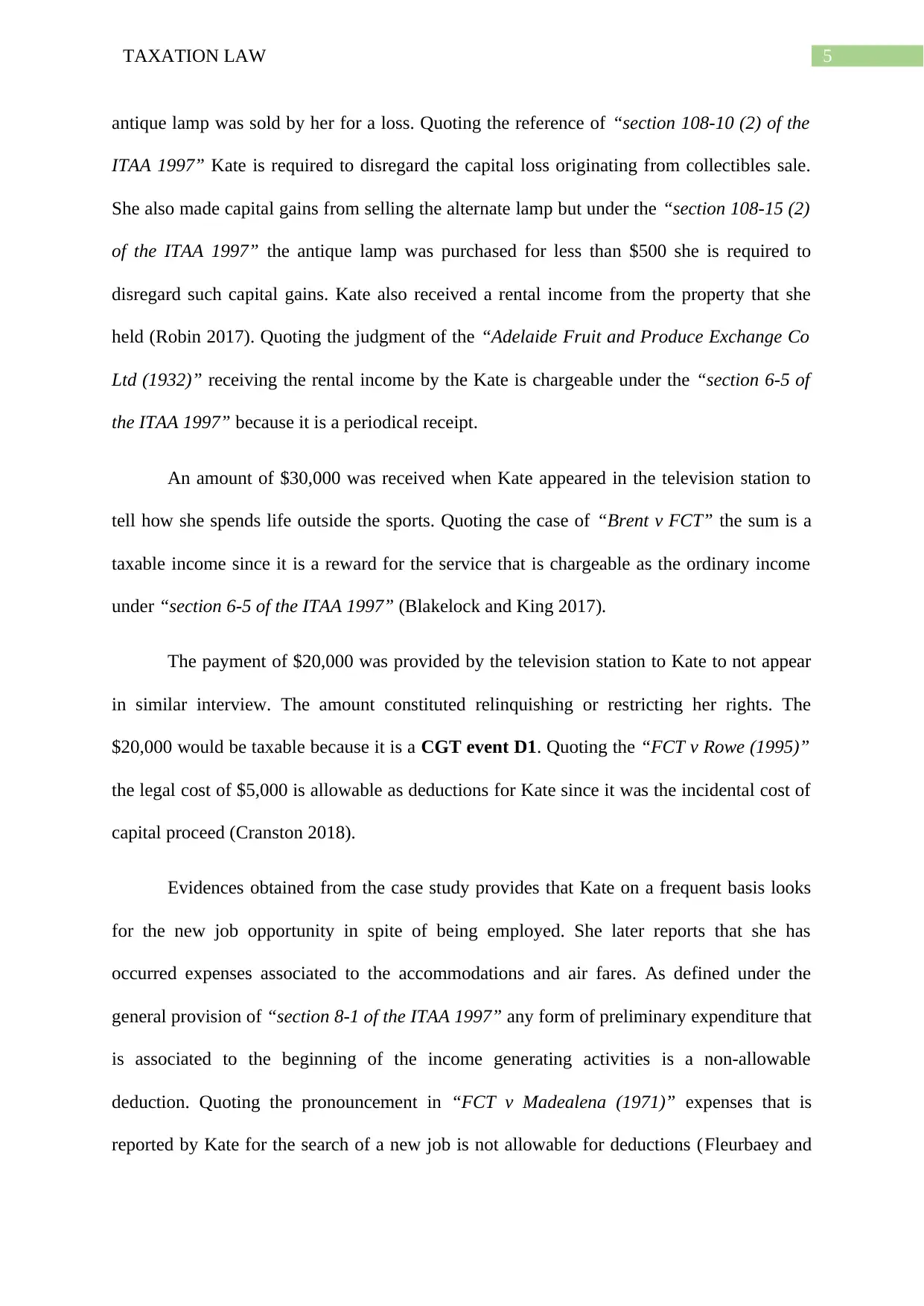
5TAXATION LAW
antique lamp was sold by her for a loss. Quoting the reference of “section 108-10 (2) of the
ITAA 1997” Kate is required to disregard the capital loss originating from collectibles sale.
She also made capital gains from selling the alternate lamp but under the “section 108-15 (2)
of the ITAA 1997” the antique lamp was purchased for less than $500 she is required to
disregard such capital gains. Kate also received a rental income from the property that she
held (Robin 2017). Quoting the judgment of the “Adelaide Fruit and Produce Exchange Co
Ltd (1932)” receiving the rental income by the Kate is chargeable under the “section 6-5 of
the ITAA 1997” because it is a periodical receipt.
An amount of $30,000 was received when Kate appeared in the television station to
tell how she spends life outside the sports. Quoting the case of “Brent v FCT” the sum is a
taxable income since it is a reward for the service that is chargeable as the ordinary income
under “section 6-5 of the ITAA 1997” (Blakelock and King 2017).
The payment of $20,000 was provided by the television station to Kate to not appear
in similar interview. The amount constituted relinquishing or restricting her rights. The
$20,000 would be taxable because it is a CGT event D1. Quoting the “FCT v Rowe (1995)”
the legal cost of $5,000 is allowable as deductions for Kate since it was the incidental cost of
capital proceed (Cranston 2018).
Evidences obtained from the case study provides that Kate on a frequent basis looks
for the new job opportunity in spite of being employed. She later reports that she has
occurred expenses associated to the accommodations and air fares. As defined under the
general provision of “section 8-1 of the ITAA 1997” any form of preliminary expenditure that
is associated to the beginning of the income generating activities is a non-allowable
deduction. Quoting the pronouncement in “FCT v Madealena (1971)” expenses that is
reported by Kate for the search of a new job is not allowable for deductions (Fleurbaey and
antique lamp was sold by her for a loss. Quoting the reference of “section 108-10 (2) of the
ITAA 1997” Kate is required to disregard the capital loss originating from collectibles sale.
She also made capital gains from selling the alternate lamp but under the “section 108-15 (2)
of the ITAA 1997” the antique lamp was purchased for less than $500 she is required to
disregard such capital gains. Kate also received a rental income from the property that she
held (Robin 2017). Quoting the judgment of the “Adelaide Fruit and Produce Exchange Co
Ltd (1932)” receiving the rental income by the Kate is chargeable under the “section 6-5 of
the ITAA 1997” because it is a periodical receipt.
An amount of $30,000 was received when Kate appeared in the television station to
tell how she spends life outside the sports. Quoting the case of “Brent v FCT” the sum is a
taxable income since it is a reward for the service that is chargeable as the ordinary income
under “section 6-5 of the ITAA 1997” (Blakelock and King 2017).
The payment of $20,000 was provided by the television station to Kate to not appear
in similar interview. The amount constituted relinquishing or restricting her rights. The
$20,000 would be taxable because it is a CGT event D1. Quoting the “FCT v Rowe (1995)”
the legal cost of $5,000 is allowable as deductions for Kate since it was the incidental cost of
capital proceed (Cranston 2018).
Evidences obtained from the case study provides that Kate on a frequent basis looks
for the new job opportunity in spite of being employed. She later reports that she has
occurred expenses associated to the accommodations and air fares. As defined under the
general provision of “section 8-1 of the ITAA 1997” any form of preliminary expenditure that
is associated to the beginning of the income generating activities is a non-allowable
deduction. Quoting the pronouncement in “FCT v Madealena (1971)” expenses that is
reported by Kate for the search of a new job is not allowable for deductions (Fleurbaey and
⊘ This is a preview!⊘
Do you want full access?
Subscribe today to unlock all pages.

Trusted by 1+ million students worldwide
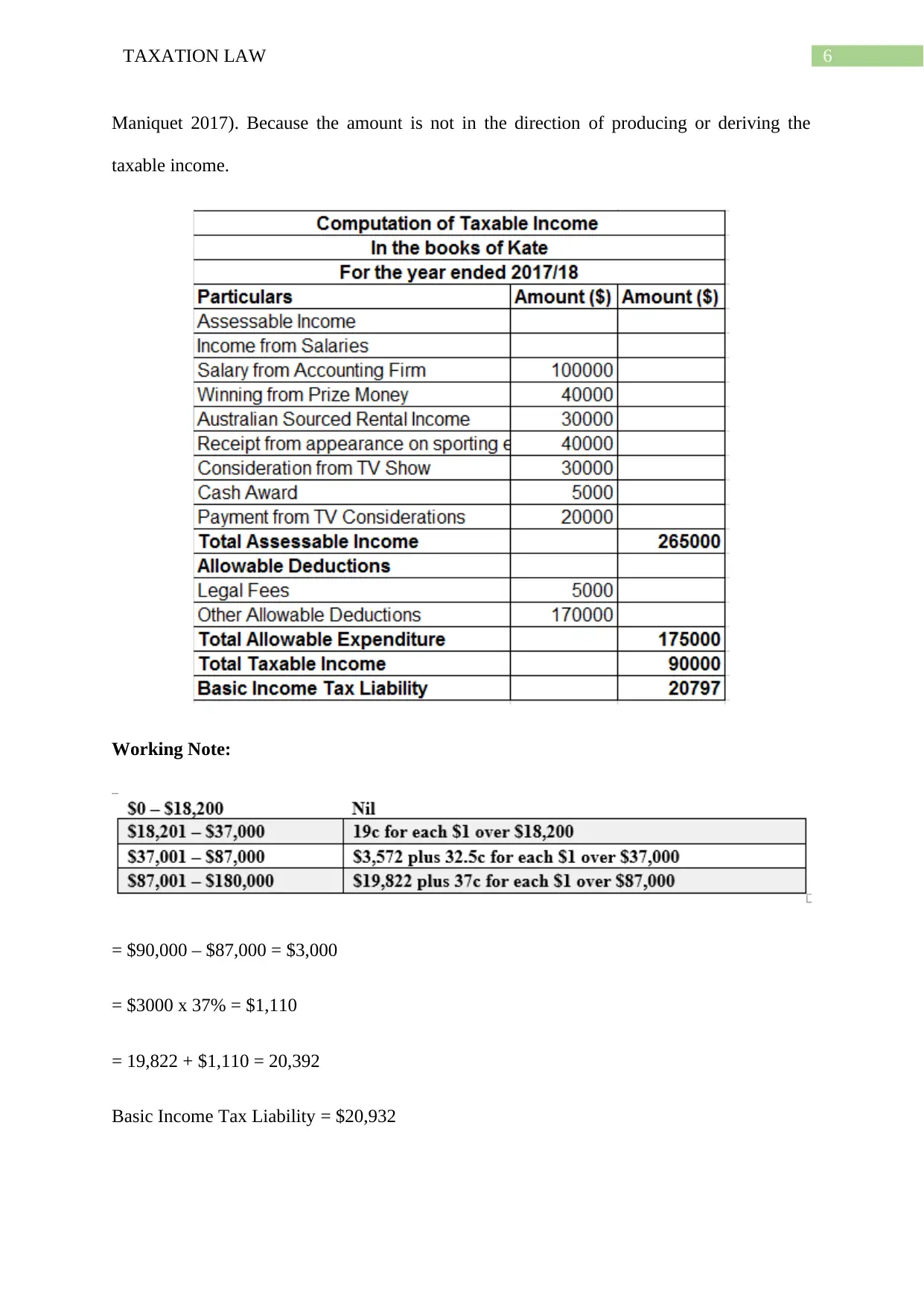
6TAXATION LAW
Maniquet 2017). Because the amount is not in the direction of producing or deriving the
taxable income.
Working Note:
= $90,000 – $87,000 = $3,000
= $3000 x 37% = $1,110
= 19,822 + $1,110 = 20,392
Basic Income Tax Liability = $20,932
Maniquet 2017). Because the amount is not in the direction of producing or deriving the
taxable income.
Working Note:
= $90,000 – $87,000 = $3,000
= $3000 x 37% = $1,110
= 19,822 + $1,110 = 20,392
Basic Income Tax Liability = $20,932
Paraphrase This Document
Need a fresh take? Get an instant paraphrase of this document with our AI Paraphraser
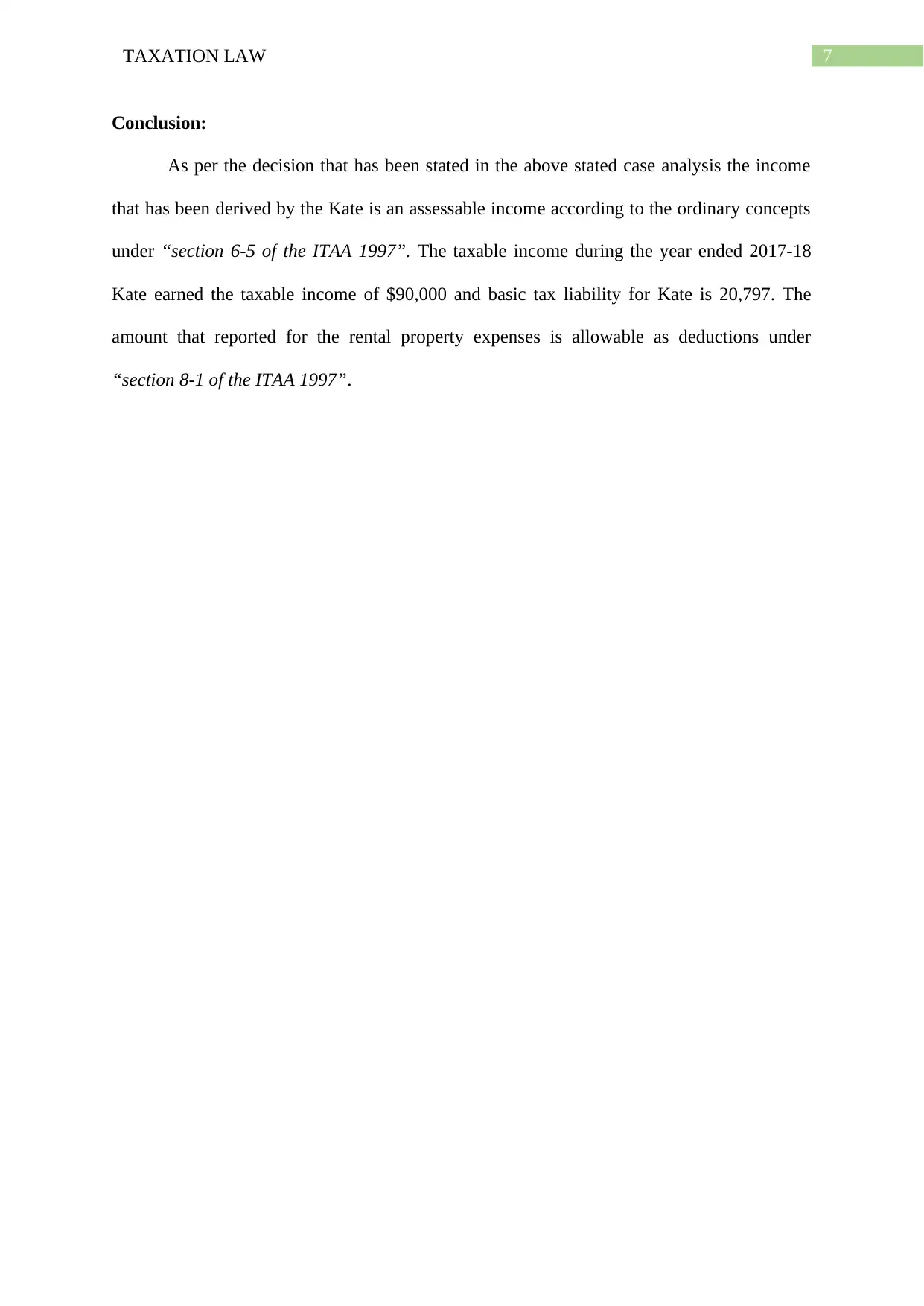
7TAXATION LAW
Conclusion:
As per the decision that has been stated in the above stated case analysis the income
that has been derived by the Kate is an assessable income according to the ordinary concepts
under “section 6-5 of the ITAA 1997”. The taxable income during the year ended 2017-18
Kate earned the taxable income of $90,000 and basic tax liability for Kate is 20,797. The
amount that reported for the rental property expenses is allowable as deductions under
“section 8-1 of the ITAA 1997”.
Conclusion:
As per the decision that has been stated in the above stated case analysis the income
that has been derived by the Kate is an assessable income according to the ordinary concepts
under “section 6-5 of the ITAA 1997”. The taxable income during the year ended 2017-18
Kate earned the taxable income of $90,000 and basic tax liability for Kate is 20,797. The
amount that reported for the rental property expenses is allowable as deductions under
“section 8-1 of the ITAA 1997”.
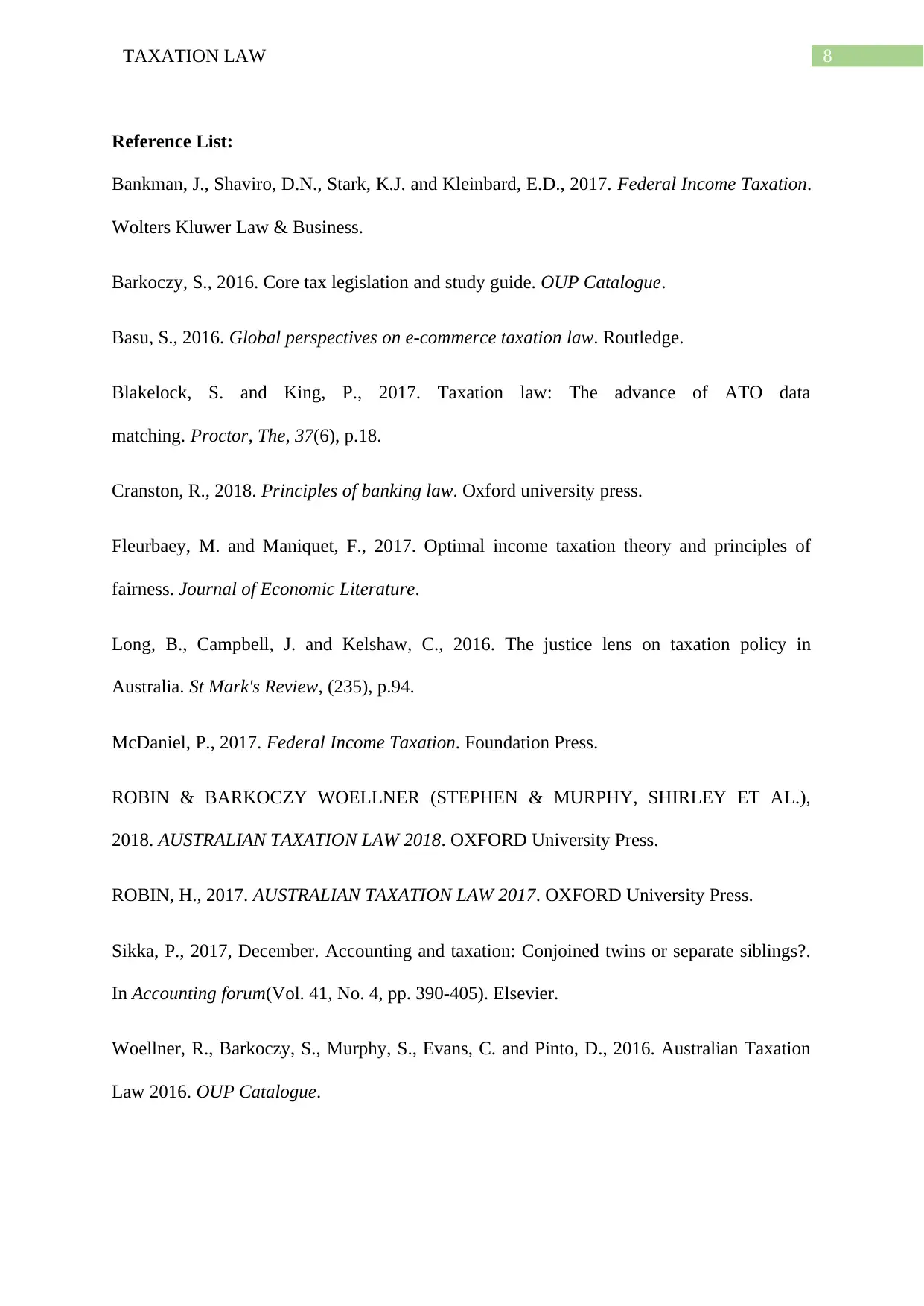
8TAXATION LAW
Reference List:
Bankman, J., Shaviro, D.N., Stark, K.J. and Kleinbard, E.D., 2017. Federal Income Taxation.
Wolters Kluwer Law & Business.
Barkoczy, S., 2016. Core tax legislation and study guide. OUP Catalogue.
Basu, S., 2016. Global perspectives on e-commerce taxation law. Routledge.
Blakelock, S. and King, P., 2017. Taxation law: The advance of ATO data
matching. Proctor, The, 37(6), p.18.
Cranston, R., 2018. Principles of banking law. Oxford university press.
Fleurbaey, M. and Maniquet, F., 2017. Optimal income taxation theory and principles of
fairness. Journal of Economic Literature.
Long, B., Campbell, J. and Kelshaw, C., 2016. The justice lens on taxation policy in
Australia. St Mark's Review, (235), p.94.
McDaniel, P., 2017. Federal Income Taxation. Foundation Press.
ROBIN & BARKOCZY WOELLNER (STEPHEN & MURPHY, SHIRLEY ET AL.),
2018. AUSTRALIAN TAXATION LAW 2018. OXFORD University Press.
ROBIN, H., 2017. AUSTRALIAN TAXATION LAW 2017. OXFORD University Press.
Sikka, P., 2017, December. Accounting and taxation: Conjoined twins or separate siblings?.
In Accounting forum(Vol. 41, No. 4, pp. 390-405). Elsevier.
Woellner, R., Barkoczy, S., Murphy, S., Evans, C. and Pinto, D., 2016. Australian Taxation
Law 2016. OUP Catalogue.
Reference List:
Bankman, J., Shaviro, D.N., Stark, K.J. and Kleinbard, E.D., 2017. Federal Income Taxation.
Wolters Kluwer Law & Business.
Barkoczy, S., 2016. Core tax legislation and study guide. OUP Catalogue.
Basu, S., 2016. Global perspectives on e-commerce taxation law. Routledge.
Blakelock, S. and King, P., 2017. Taxation law: The advance of ATO data
matching. Proctor, The, 37(6), p.18.
Cranston, R., 2018. Principles of banking law. Oxford university press.
Fleurbaey, M. and Maniquet, F., 2017. Optimal income taxation theory and principles of
fairness. Journal of Economic Literature.
Long, B., Campbell, J. and Kelshaw, C., 2016. The justice lens on taxation policy in
Australia. St Mark's Review, (235), p.94.
McDaniel, P., 2017. Federal Income Taxation. Foundation Press.
ROBIN & BARKOCZY WOELLNER (STEPHEN & MURPHY, SHIRLEY ET AL.),
2018. AUSTRALIAN TAXATION LAW 2018. OXFORD University Press.
ROBIN, H., 2017. AUSTRALIAN TAXATION LAW 2017. OXFORD University Press.
Sikka, P., 2017, December. Accounting and taxation: Conjoined twins or separate siblings?.
In Accounting forum(Vol. 41, No. 4, pp. 390-405). Elsevier.
Woellner, R., Barkoczy, S., Murphy, S., Evans, C. and Pinto, D., 2016. Australian Taxation
Law 2016. OUP Catalogue.
⊘ This is a preview!⊘
Do you want full access?
Subscribe today to unlock all pages.

Trusted by 1+ million students worldwide
1 out of 9
Related Documents
Your All-in-One AI-Powered Toolkit for Academic Success.
+13062052269
info@desklib.com
Available 24*7 on WhatsApp / Email
![[object Object]](/_next/static/media/star-bottom.7253800d.svg)
Unlock your academic potential
Copyright © 2020–2025 A2Z Services. All Rights Reserved. Developed and managed by ZUCOL.





